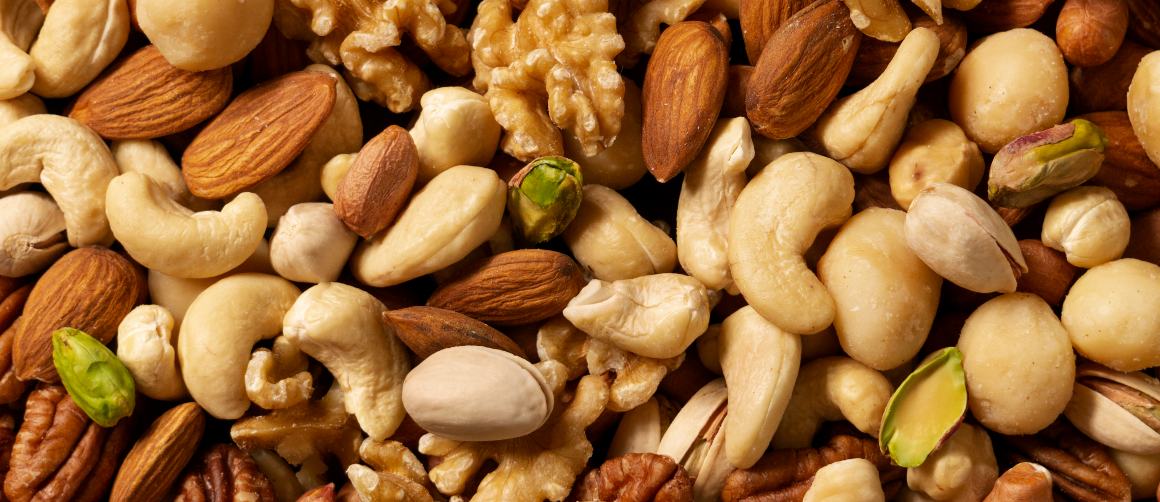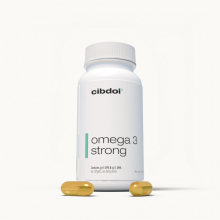Do Nuts Contain High Levels of Omega-6 Fatty Acids?
Published:
Nuts are nutritious and linked to many health benefits. However, some sources claim that nuts are high in omega-6 fatty acids. This raises concerns about potential negative effects on inflammation and health.
Contents:
But are nuts actually high in omega-6s compared to omega-3s? Let's analyze the omega-6 content of different nuts to find out.

Overview of Omega-6 Fatty Acids
Omega-6 fatty acids are a type of polyunsaturated fat found in many plant foods.
The primary omega-6 fat is linoleic acid (LA). Arachidonic acid (AA) is also obtained from food sources.
Omega-6s are considered essential fats that must be obtained through your diet. They provide both benefits and potential drawbacks:
Potential Benefits:
- Support growth and development.
- Help regulate metabolism and reproduction.
- Maintain bone health.
- Provide anti-inflammatory effects at moderate intake.
Potential Drawbacks:
- Promote inflammation at very high intakes.
- May reduce anti-inflammatory omega-3 benefits.
Ideally, omega-6 intake should be balanced with omega-3 intake at a ratio around 2:1 to 4:1 omega-6 to omega-3.
The typical Western diet tends to provide excessive omega-6 compared to omega-3, which may cause problems.
But do nuts contribute to this potentially unhealthy imbalance? Let's find out.
Omega-6 Fatty Acids in Nuts
Here is the typical omega-6 content in one ounce (28 grams) of different raw nuts:
- Walnuts: 10 grams omega-6
- Pecans: 12 grams
- Hazelnuts: 5 grams
- Almonds: 12 grams
- Pistachios: 13 grams
- Cashews: 8 grams
- Peanuts: 18 grams
Nuts do contain significant amounts of omega-6. But they also provide omega-3 ALA fat, fiber, minerals, antioxidants and other beneficial nutrients.
And the ratio of omega-6 to omega-3 in nuts may not be as concerning as some claims suggest.
Omega-6 to Omega-3 Ratio of Nuts
Here is the typical ratio of omega-6 to omega-3 fatty acids in common nuts:
- Walnuts: 4:1 ratio
- Pecans: 20:1
- Hazelnuts: 46:1
- Almonds: 12:1
- Pistachios: 27:1
- Cashews: 6:1
- Peanuts: 32:1
While omega-6 is higher than ideal compared to omega-3, most nuts are still around or under the 10:1 ratio some experts recommend (1).
Walnuts and cashews, in particular, have more favorable ratios.
Also, the form of omega-6 in nuts may be less inflammatory than refined vegetable oils high in omega-6.
So despite decent omega-6 quantities, nuts may not promote inflammation or imbalance as much as claimed when eaten in moderation.
Potential Benefits of Omega-6 Fatty Acids
Although high intake from modern diets is likely unhealthy, omega-6 fatty acids still provide benefits at moderate levels.
Potential advantages of the omega-6s found in nuts include:
- Supporting growth and development.
- Aiding metabolism and reproduction.
- Maintaining bone health.
- Providing anti-inflammatory effects.
- Supporting skin and hair health.
As part of a nutritious diet with adequate omega-3s, the omega-6s in nuts likely contribute more benefits than drawbacks for most people.
Strategies to Balance Omega-6 in Nuts
Here are some tips to get the benefits of omega-6 while minimizing potential downsides from nuts:
Eat a Variety of Nuts
Eating a mix of different nuts helps balance intake.
Favor nuts lower in omega-6 like walnuts, cashews and hazelnuts more often.
Watch Portion Sizes
Limit portions to around 1 ounce of nuts per serving to keep omega-6 amounts moderate.
Increase Omega-3s
Pair nuts with other foods rich in omega-3s:
- Fatty fish like salmon
- Seeds such as flax, chia and hemp
- Green leafy vegetables
- Omega-3-rich oils
- Fortified eggs or dairy
Use Nuts in Recipes
Add small amounts of chopped nuts to dishes along with ingredients providing omega-3 ALA:
- Salads with fatty dressings, leafy greens or seeds
- Yogurt with flax or chia seeds
- Stir fries with oils and veggies
- Oatmeal with walnuts and flaxseeds
- Chicken dishes with herbs and oils
Limit Refined Vegetable Oils
Avoid overconsuming refined oils high in omega-6 like soybean, corn and cottonseed oils.
Prioritize oils higher in monounsaturated and omega-3 fats instead, such as:
- Olive oil
- Avocado oil
- Canola oil
- Walnut oil
- Flaxseed oil
The omega-6 content of nuts is unlikely to cause problems within a balanced diet rich in plant and marine sources of anti-inflammatory omega-3s.
Healthiest Nuts for Omega-3s
These nuts provide higher amounts of ALA omega-3s to balance omega-6 intake:
- Walnuts: 2,500 mg omega-3 ALA per ounce.
- Pecans: 100 mg omega-3 ALA.
- Hazelnuts: None significant.
- Almonds: None significant.
- Pistachios: 80 mg omega-3 ALA.
- Cashews: 20 mg omega-3 ALA.
- Peanuts: None significant.
Walnuts clearly stand out, with pecans and pistachios providing much smaller but helpful omega-3 amounts.
Prioritize eating walnuts regularly along with other omega-3-rich foods.
Top Sources of Omega-3 Fatty Acids
To balance intake of omega-6 fats, make sure to get ample omega-3s from:
EPA/DHA Sources:
- Fatty fish: Salmon, sardines, mackerel, herring, trout
- Other seafood: Oysters, mussels, crab
- Fish oil and algal supplements
- Grass-fed meat and dairy
ALA Sources:
- Oils: Flaxseed oil, canola oil, soybean oil
- Nuts: Walnuts, pecans, pistachios
- Seeds: Flaxseeds, chia seeds, hemp seeds
- Green leafy vegetables
Aim for at least two servings of fatty fish weekly and include omega-3-rich plant foods daily.
Omega-6 in Nuts: Key Takeaways
In summary:
- Nuts do contain significant amounts of the omega-6 fat linoleic acid.
- But most have an omega-6 to omega-3 ratio around 10:1 or less, which may be healthy in moderation.
- Walnuts and cashews have more favorable ratios than other nuts.
- Omega-6 from nuts may be less inflammatory than refined vegetable oils high in omega-6.
- Balance omega-6 in nuts by eating walnuts, watching portions, and increasing omega-3s.
Conclusion
Nuts supply beneficial omega-6 fatty acids, as long as intake is balanced with anti-inflammatory omega-3 fats from seafood, oils, seeds and other sources.
Eating a variety of nuts in moderation as part of a diet adequate in omega-3s can allow you to gain their many nutritional benefits without problematic excess omega-6 intake.















